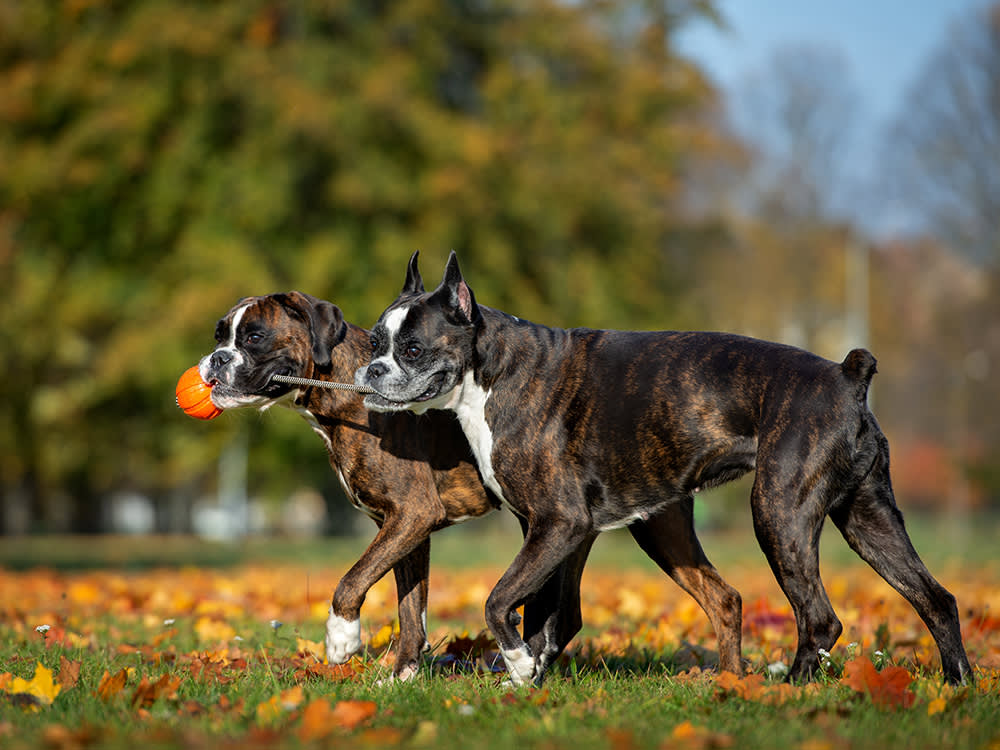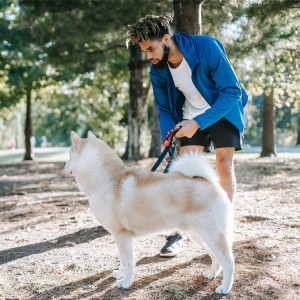Docked Tails Play a Role in Dog Communication
Looks aren’t everything, but they can talk

share article
Your dog is not mysterious about how they feel. When you get home, they greet you at the door with kisses. When you lace up your shoes, they try to lure you back with a request for belly rubs because they’re sad you’re leaving. But here’s one thing you can’t so easily tell from your dog: how they’ll behave based on their breed.
People often cite breed when trying to account for the ways dogs behave. But according to Christine Hibbard, owner of Companion Animal Solutionsopens in a new tab in Seattle, when associating a dog with the ‘look’ or ‘behaviour’ of a particular breed, it’s important to remember that “the way dogs look and their actual genetics can be very different”.
That is, at least, what studies are showing. As Dr Victoria Voith, a veterinary behaviourist at Western University of Health Sciences in California explains, “Mixed breed dogs are a collage of features of their ancestors. So much so that they often don’t look like any of their immediate parents or grandparents. In fact, they may look more like other breeds.”
No two dogs alike
DNA tests often reveal that dogs are not simply a cross between two purebred parents. Instead, tests often come back with percentages of varying breeds – many of which you could never have guessed by appearance. Since a dog’s looks and their genetic code can be on very different pages – sometimes in different books altogether – attributing a dog’s behaviour to how they look can sometimes be a faulty assumption.
This even applies to purebred dogs to a degree despite their concentrated breeding pools. As Denise Herman, lead trainer and founder of Empire of the Dog in New York City, says, “When you get a puppy of a particular breed, people think it’s a blank slate, but it’s really an unknown slate. Breed gives an indication of where that unknown slate may go, but not all Border Collies herd, not all Huskies pull sledges and some Chows like everyone equally. A puppy of a particular breed is an unknown slate with the possibility of those characteristics.”
While genetics get a dog started, developmental factors such as environment, learning and individual life experiences make each dog who they are. No two dogs on the planet will have the exact same life experiences. Which means no two dogs, even of the same breed, will have the exact same personality or responses to similar situations. However, the means of expressing those reactions can very much be related to physical attributes.
Mixed signals
According to Dr Stephen Zawistowski, science advisor to the American Society for the Prevention of Cruelty to Animals (ASPCA), “There are some things that are anatomically not possible for a dog to do. How can you tell if a Basset Hound has their ears up and forwards? A Rottweiler can make a great lip pucker, but how on earth can a Bulldog pucker?”
To be sure, the lack of overt behavioural signals does not suggest a dog is not feeling a particular emotion, or even that they might not adopt different strategies to convey them. But the implication is clear: the perception that Rottweilers are aggressive and Basset Hounds are laid-back could be a function of their physical features – and thus, the behaviours they can perform – rather than their mental processes.
With this in mind, could a dog’s physical appearance affect how they communicate? Or even, for that matter, how they’re treated by other members of their species? Dr Jim Ha, research associate professor and staff member of Companion Animal Solutions in Seattle breaks it down.
“The way dogs look – their morphology – can definitely change the quality of their visual signal,” says Dr Ha. “Dogs who are more infantile in appearance – paedomorphic dogs like French Bulldogs, Pugs and Cavalier King Charles Spaniels – are nice examples of how we are handicapping the dog’s ability to signal properly. But we also find that dogs who are not paedomorphic in appearance can have trouble signalling and communicating with one another as well. Signalling difficulty is not only associated with paedomorphic dogs.”
Impact of docked tails
Dr Ha suggests that many aggression issues stem from the misuse of signals and miscommunication between dogs. A prime example is dog tails come in a spectrum of shapes and sizes. When asked to assess dog behaviour, humans tend to pay an inordinate amount of attention to the tail. But is the same true for dog-to-dog communication?
When researchers behind the journal Behavioral and Brain Functionsopens in a new tab explored how dogs respond to other dogs’ tails, they pulled out the big guns: a model robot resembling a Labrador Retriever. Apart from its tail, the ‘dog’ was motionless. The researchers found that when the bot had a long wagging tail, it was approached more than when it had a long still tail – which as you probably assumed, suggests that the tail conveys emotional state and that wagging is more inviting than not wagging.
When it came to short tails, the story changed. There was no difference between how the robot dog with a short/still and a short/wagging tail was approached. It appears that the longer tails were most effective at conveying emotional information, and since short tails are hard to read, they might not be read at all.
For Herman, the implications are obvious. “When you dock tails, it takes away part of their communication signal – essentially the dog version of botox. Ear cropping falls in the same category. Dobermans with cropped ears ostensibly look alert to other dogs. They can’t be read accurately because they can’t change it.” It’s difficult to derive cues and information from cropped ears. If anything, their constantly alert position could be misleading to other dogs.
E’Lise Christensen, a board-certified veterinary behaviourist in New York City, agrees. “I think cosmetic alteration could affect communication with other dogs. It certainly has an impact on assessments by owners, because they forget to look at the stump of the tail for movement and tension. Ears that are too cropped mean owners have to look for muscular movement at the skull level rather than the pinna, the outer part of the ear, where we customarily look. Flat faces make it more difficult to read small muscular movements.”
Herman suggests that taking note of a dog’s morphology can give pet parents a better appreciation for their dog. “It’s hard for other dogs to see that a Chow is really stiff, simply because they are engulfed in a ball of hair. It can be helpful for dog parents to recognise that what dogs have or do not have at their disposal could add confusion in dog to dog communication. This appreciation could help people empathise with their dog, instead of blaming their dog or feeling angry for the dog’s behaviour.”
Hibbard reminds us that the issue at hand can be twofold, “If you can’t see the ears, that’s one problem. But if you can see the ears but the dog uses them wrong, that’s another problem.”
It’s all about us
No dog story is complete without the human element. Many pet professionals believe there should be guidelines or legislation set for these cosmetic alterations. In the UK, tail docking is considered to be mutilation where it was banned in 2007 with an exemption for some working dogs, many European nations banned these practices in 1987opens in a new tab.
Aside from the health consequences, what do we do to a dog’s ability to speak to us when we cut off this important communication tool? Could morphology play a role in the way dogs and humans interact? Dogs excel at being in sync with us, whether on the agility course or when they’re trying to figure out if we’re going into the bathroom versus the far more enticing kitchen. But not unlike the chemistry in a long-term relationship, sometimes dogs are out of sync.
Training, life experience, genetics and psychological disorders are the common suspects for ‘out-of-sync’ behaviour, but how a dog looks – or rather, sees – is often overlooked. In 2003, Professor Paul McGreevy, a researcher at the University of Sydney, and his colleagues discovered that, contrary to popular belief, all canine eyes are not the sameopens in a new tab. Short-nosed dogs have what is called an area centralis, which allows them to focus more clearly on the world in front of them, like humans, while long-nosed dogs have a visual streak, which enables better peripheral vision. There’s a physiological reason why a long-nosed dog would take off after something way in the periphery while you and a short-nosed dog continue to sit on a park bench wondering what the long-nosed dog saw.
It stands to reason that these differences would not only affect how dogs see the world around them, but also how they attend to us humans, and that’s exactly what we find. Dogs are quite adept at following our pointing gestures, but brachycephalic (flat-faced) breeds, with their more forward-facing eyes, follow these gestures better than dolichocephalic (long-nosed) breeds. In turn, this sense of being seen and responded to accordingly (or not) may affect how we perceive and relate to dogs.
Undoubtedly, dogs are a composite of their genes and individual life experiences. But the physical features that they come with, or that we give them via docking and breeding, can contribute to how they interact with others and are perceived by dogs and humans alike. When thinking about why your dog behaves the way they do, it’s one of the few instances where it can be helpful to be superficial and look at what’s right in front of you.

Julie Hecht, MSc
Julie Hecht, MSc, is a PhD candidate studying animal behavior at the Graduate Center, CUNY, and author of the Dog Spies blog at Scientific American. She would really like to meet your dog.
Related articles
![Black dog sitting on tiled floor]() opens in a new tab
opens in a new tabWhat’s Better Than a Tail Wag? A Circle Wag
Also called the ‘propeller wag’ or ‘helicopter tail’, this behaviour is a surefire way to tell that a dog is happy
![man unleashing dog in a park]() opens in a new tab
opens in a new tab6 Steps to Improve Your Dog’s Recall Training
Teach your pup a perfect recall so you can be sure they will come back, no matter what
![Sad boxer rests on owners lap, dog doesn't want to be touched]() opens in a new tab
opens in a new tabDon’t Ignore These 9 Behavioural Signs That Your Dog Is in Pain
Animal behaviourist Karen B London breaks down the silent ways your pet is trying to tell you they’re hurting
![training dog chewing blanket]() opens in a new tab
opens in a new tabWhy Does My Dog Chew On Blankets?
A (seemingly) unstoppable nibbling obsession with all the blankets
![Owner serving dog food]() opens in a new tab
opens in a new tabYour Dog’s Food Aggression Isn’t Cute – Here’s How You Can Work On It
No longer associate feeding time with growling time
![A dog resting its face on a wooden table.]() opens in a new tab
opens in a new tabDo Dogs Grieve When Other Dogs Die?
A new study confirms our pets can have heartbreaking reactions to the loss of a canine companion








